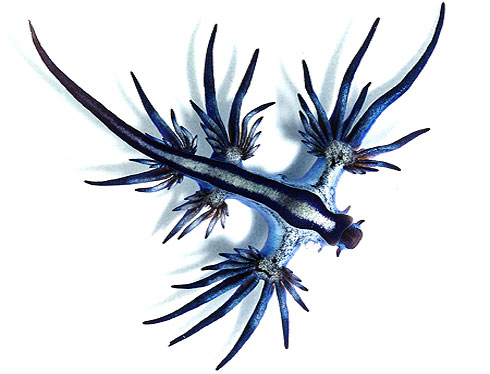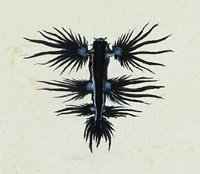For once, the Internet is not lying to you


This is actually a real life animal.
This is the Glaucus atlanticus. It is a type of nudibranch—shell-less mollusks known for their extravagant shapes and colors. It is venomous.

You see all those pointy bits Glaucus atlanticus? According to the Natural History Museum, those are called cerata. They are the organs where G. atlanticus stores the stinging cells that it steals from the jellyfish it eats.
Because it eats jellyfish. And not just any jellyfish—but Portuguese Man o' War jellyfish. G. atlanticus eats the jellyfish tentacles and, as part of the process of digestion, stores stinging cells from those tentacles in the tips of its cerata. Then G. atlanticus gets to be venomous, too. Fun! Sharing!
Here's how the Smithsonian Magazine blog described the process last Spring:
A gas-filled sac in the stomach allows the small slug to float, and a muscular foot structure is used to cling to the surface. Then, if it floats by a man o’ war or other cnidarian, the blue dragon locks onto the larger creature’s tentacles and consumes the toxic nematocyst cells that the man o’ war uses to immobilize fish.In conclusion, there are two lessons to take away from G. atlanticus.
The slug is immune to the toxins and collects them in special sacs within the cerata—the finger-like branches at the end of its appendages—to deploy later on. Because the man o’ war’s venom is concentrated in the tiny fingers, blue dragons can actually have more powerful stings than the much larger creatures from which they took the poisons.
First, the Internet isn't always lying to you. Just sometimes.
Second, don't touch things that look pretty. Because they will probably kill you.
More at The Encyclopedia of Life
A scientific paper documenting the presence of G. atlanticus in Andhra Pradesh.
The Sea Slug Forum has a description, photos, and sightings.

No comments:
Post a Comment